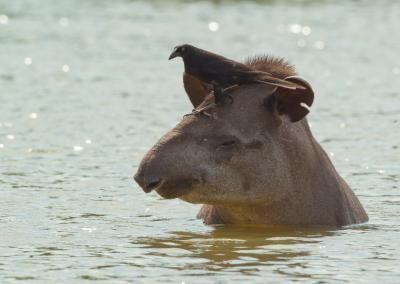
Haven for South America's Largest Land Mammal Found

A large population of threatened lowland tapir, a strange beast with a trunk-like nose that frequents rain forests and grasslands, has been found in a series of parks spanning the remote Peru-Bolivia border in South America.
The census, conducted by scientists from the Wildlife Conservation Society and elsewhere, estimated there are at least 14,500 of the animals in the area. The study, published last month in the journal Integrative Zoology, relied on photographs from camera traps, as well as interviews with park rangers and subsistence hunters, according to a release from the WCS. The animals live in a series of connecting parks in northwest Bolivia and southeastern Peru.
Lowland tapirs, also known as Brazilian tapirs, are the largest land mammals that live solely in South America, growing up to 660 pounds (300 kg), according to the WCS. They are considered vulnerable by the International Union for Conservation of Nature, a global network of government and private groups that assesses the extinction risk of species. Their numbers have decreased by more than 30 percent in the last 33 years, and are expected to decline by the same amount in the next 30 or so years, the ICUN reports. They are threatened by logging, habitat loss, hunting and competition with livestock.
"Although this rate of decline seems improbable considering the occurrence in the vast Amazon — the fact is that the species has been extirpated over large portions of its range and severely reduced in other large portions," according to the IUCN. "Lowland tapir populations seem unlikely to persist anywhere humans occur at densities any greater than 1 per square kilometer [2.6 per square mile]."
The network of parks where the tapirs were counted, known as the Madidi-Tambopata landscape, was also found to be a vital stronghold for jaguars. "These results underline the fundamental importance of protected areas for the conservation of larger species of wildlife threatened by hunting and habitat loss," lead study author Robert Wallace said in the statement.
Tapirs are doing better in parks than in other, unprotected areas, the study found. In one river valley, populations of the animal have rebounded since the creation of Madidi National Park in 1995, the WCS reported. This park is one of the most diverse places on Earth, home to 11 percent of the world's birds, more than 200 species of mammals, 300 species of fish and 12,000 plant varieties, according to the release.
The animals were found in Madidi, Pilón Lajas and Apolobamba national parks in Bolivia, and Bahuaja Sonene and Tambopata national parks in neighboring Peru.
Sign up for the Live Science daily newsletter now
Get the world’s most fascinating discoveries delivered straight to your inbox.
Reach Douglas Main at dmain@techmedianetwork.com. Follow him on Twitter @Douglas_Main. Follow OurAmazingPlanet on Twitter @OAPlanet. We're also on Facebook and Google+.












